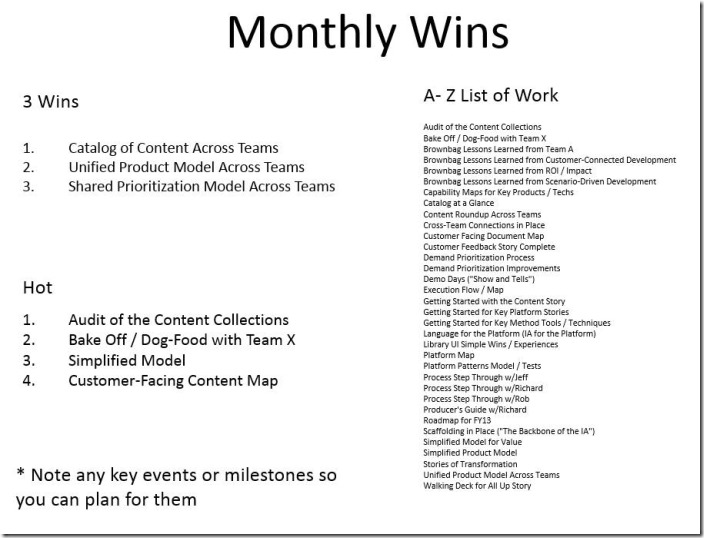Task Management for Teams
I’m a fan of monthly plans for meaningful work.
Whether you call it a task list or a To-Do list or a product backlog, it helps to have a good view of the things that you’ll invest your time in.
I’m not a fan of everybody trying to make sense of laundry lists of cells in a spreadsheet.
Time changes what’s important and it’s hard to see the forest for the trees, among rows of tasks that all start to look the same.
One of the most important things I’ve learned to do is to map out work for the month in a more meaningful way.
It works for individuals. It works for teams. It works for leaders.
It’s what I’ve used for Agile Results for years on projects small and large, and with distributed teams around the world. (Agile Results is my productivity method introduced in Getting Results the Agile Way.)
A picture is worth a thousand words, so let’s just look at a sample output and then I’ll walk through it:
What I’ve found to be the most effective is to focus on a plan for the month – actually take an hour or two the week before the new month. (In reality, I’ve done this with teams of 10 or more people in 30 minutes or less. It doesn’t take long if you just dump things fast on the board, and just keep asking people “What else is on our minds.”)
Dive-in at a whiteboard with the right people in the room and just list out all the top of mind, important things – be exhaustive, then prioritize and prune.
You then step back and identify the 3 most important outcomes (3 Wins for the Month.)
I make sure each work item has a decent name – focused on the noun – so people can refer to it by name (like mini-initiatives that matter.)
I list it in alphabetical by the name of the work so it’s easy to manage a large list of very different things.
That’s the key.
Most people try to prioritize the list, but the reality is, you can use each week to pick off the high-value items. (This is really important. Most people spend a lot of time prioritizing lists, and re-prioritizing lists, and yet, people tend to be pretty good prioritizing when they have a quick list to evaluate. Especially, if they know the priorities for the month, and they know any pressing events or dead-lines. This is where clarity pays off.)
The real key is listing the work in alphabetical order so that it’s easy to scan, easy to add new items, and easy to spot duplicates.
Plus, it forces you to actually name the work and treat it more like a thing, and less like some fuzzy idea that’s out there.
I could go on and on about the benefits, but here are a few of the things that really matter:
- It’s super simple. By keeping it simple, you can actually do it. It’s the doing, not just the knowing that matters in the end.
- It chops big work down to size. At the same time, it’s easy to quickly right-size. Rather than bog down in micro-management, this simple list makes it easy to simply list out the work that matters.
- It gets everybody in the game. Everybody gets to look at a whiteboard and plan what a great month will look like. They get to co-create the journey and dream up what success will look like. A surprising thing happens when you just identify Three Wins for the Month.
I find a plan for the month is the most useful. If you plan a month well, the weeks have a better chance of taking care of themselves. But if you only plan for the week or every two weeks, it’s easy to lose sight of the bigger picture, and the next thing you know, the months go by. You’re busy, things happen, but the work doesn’t always accrue to something that matters.
This is a simple way to have more meaningful months.
I also can’t say it enough, that it’s less about having a prioritized list, and more about having an easy to glance at map of the work that’s in-flight. I’m glad the map of the US is not a prioritized list by states. And I’m glad that the states are well named. It makes it easy to see the map. I can then prioritize and make choices on any trip, because I actually have a map to work from, and I can see the big picture all at once, and only zoom in as I need to.
The big idea behind planning tasks and To-Do lists this way is to empower people to make better decisions.
The counter-intuitive part is first exposing a simple view of the map of the work, so it’s easy to see, and this is what enables simpler prioritization when you need it, regardless of which prioritization you use, or which workflow management tool you plug in to.
And, nothing stops you from putting the stuff into spreadsheets or task management tools afterwards, but the high-value part is the forming and storming and conforming around the initial map of the work for the month, so more people can spend their time performing.
May the power of a simple information model help you organize, prioritize, and optimize your outcomes in a more meaningful way.
If you need a deeper dive on this approach, and a basic introduction to Agile Results, here is a good getting started guide for Agile Results in action.
